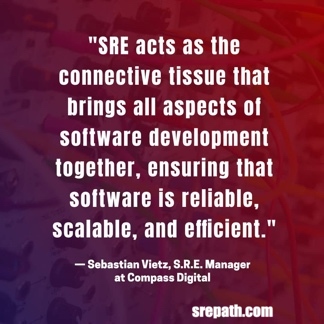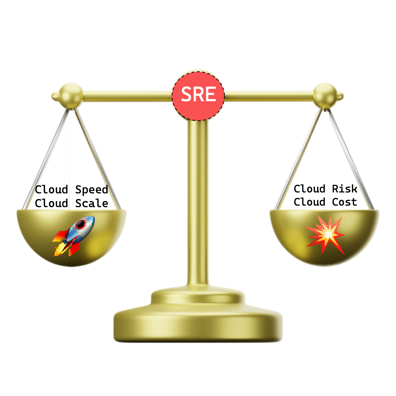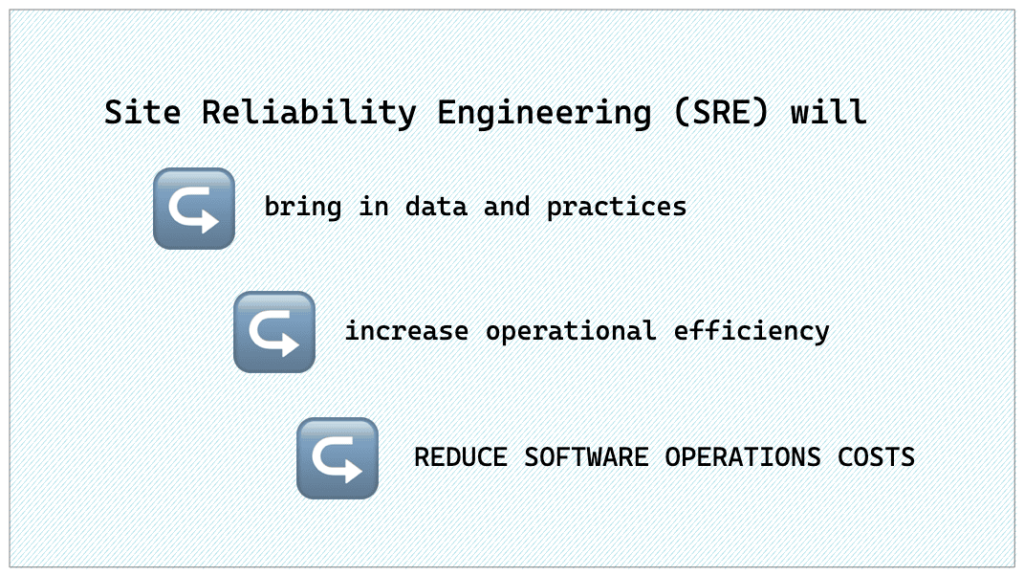This article will help you communicate the advantages of SRE to stakeholders through 3 arguments. It is part of the SRE Digital Transformation series exploring how to integrate SRE into your organization.
Introduction
It takes confidence and conviction to introduce significant changes that may affect the entire team or organization.
You will naturally face resistance or hesitation when introducing change.
But proposing a new function like Site Reliability Engineering (SRE) or restructuring teams toward it can bring significant benefits.
With careful planning, clear communication, and an emphasis on the potential benefits, it can be a successful endeavor.
I will share more specific communication advice with you in a moment.
But let’s first consider 3 arguments that you can use to strengthen the logic behind your proposal.
Philosophical arguments for SRE
Argument 1 – SRE is the connective tissue for all other disciplines

Let’s unpack the above statement in a few key points:
- Site Reliability Engineering (SRE) as a discipline can act as a foundation for all other related fields.
- SRE teams are responsible for designing and implementing new tools and technologies to improve the overall efficiency and effectiveness of software systems.
- SREs work closely with developers, product managers, and other stakeholders to ensure that the systems meet the needs of the organization and its customers.
- For example, SREs can support AppSec engineers and teams in navigating system complexity to identify and mitigate security threats and vulnerabilities
Argument 2 – SRE balances the risk versus benefit of cloud computing

Cloud computing has revolutionized the way we do business today, especially in regulated industries.
While it offers numerous advantages, it is also a double-edged sword that comes with its own set of challenges.
One of the biggest challenges is the inability to set controls on IT like we used to.
As organizations move to cloud-native services, the risk of security breaches and data loss increases exponentially.
How do we balance our need for flexibility with the need to reduce risk?
How can we ensure that we are not compromising on security and compliance while still maintaining productive velocity?
Site Reliability Engineers (SREs) can play a crucial role in ensuring the smooth functioning of cloud-based systems.
Let’s unpack how they can handle the double-edged sword of cloud flexibility/scale vs. cloud risk.
They are responsible for a wide range of tasks, from educating engineers about best practices to setting up passive guardrails that prevent mistakes and mitigate risks.
In order to educate engineers, SREs possess a deep understanding of the underlying systems and technologies being used.
This allows them to provide guidance on how to use the cloud in the most efficient and effective way possible, while still staying within the bounds of established policies.
In addition to providing guidance, SREs also set up passive guardrails that help prevent errors and reduce risk.
These guardrails can take many forms, from automated testing to monitoring and alerting.
By setting up these guardrails, SREs can help ensure that cloud-based systems are more resilient and better able to handle unexpected events.
Moreover, SREs frequently possess excellent interpersonal skills, and experienced engineers can confidently engage with different stakeholders in the risk management process.
In conclusion, while cloud software presents both opportunities and challenges, it is up to organizations to strike a balance between flexibility and risk.
An effective SRE function can help strike this balance.
Argument 3 – SRE supports operational efficiency and cost control

SRE can make a wide range of data visible in the software system.
This includes but is not limited to service performance across the entire value stream.
By providing a deeper view of the system, SRE can identify potential bottlenecks and areas of improvement that may have been overlooked otherwise.
In terms of practices, SRE can implement a variety of strategies to improve the system.
One of the most important is a better response to incidents.
By proactively addressing incidents as they occur, SRE can reduce the severity of future incidents, some of which can incur significant financial damage.
Other strategies that SRE can implement include improving DevSecOps practices, which can help prevent costly security mishaps in a growing threat environment.
By taking a comprehensive and proactive approach to system management, SRE can help ensure the long-term success and financial viability of the software system.
Tips for communicating with stakeholders
Use plain language
Use language that highlights to stakeholders that SRE:
- Solves problems for users, not the system
- Benefits the business, not just technology
Sell the benefits clearly
Here are 5 examples in addition to the above key arguments showing how SREs clearly benefit the business:
- Save on cloud computing costs with potential savings up to $100000+/month on cloud computing costs – “make your CFO happy”
- Reduce the potential of active security threats by increasing passive security of software through DevSecOps – “make your CISO happy”
- Prevent the loss of revenue caused by downtime by increasing the resilience, performance, and overall reliability of software
- Avoid outsized headcount growth while still scaling up the growth of software operations – 10x manual operations efforts through automation
- Assure fast product launches through continued developer velocity by improving DevOps of developer i.e. “shift left”
Temporarily align your pitch with the “project mindset”
When dealing with stakeholders, it is important to keep in mind that they often approach a new way of work with a specific mindset.
This is the “project mindset”, where there is a clear beginning and end to a project.
However, this can conflict with the continuous improvement mindset that’s necessary for the long-term efficacy of Site Reliability Engineering (SRE) functions.
To avoid confusion, it may initially be more effective to pitch a “maturity model” for the SRE team.
The maturity model gives a fair start to the SRE function while also satisfying project-oriented mindsets.
This model would allow for a clear path to success, with specific milestones and an “end state” that demonstrates progress.
By presenting this model, stakeholders will be able to better understand the goals of the SRE team and how they plan to achieve them.
Of course, it is important to note that maturity models are not necessarily the ideal state for achieving a true return on investment.
However, in the initial pitch, it may be best to focus on the benefits of a clear path to success and avoid confusing stakeholders with more complex arguments.
As the project progresses and the SRE team continues to add new capabilities, it may be possible to revisit the idea of continuous improvement and how it can contribute to long-term success.
Position for budgeting
When presenting your change proposal to executives, it’s important to remember that they often have a strong focus on budgets as well as “project mindsets”.
Even if they don’t explicitly mention it, these factors are likely at the forefront of their minds. Therefore, it’s crucial to pitch your change in a way that takes into account the executives’ priorities and any budgetary challenges they may be facing.
In essence, as the person proposing the change, you are functioning as an internal salesman.
This means that you need to be able to effectively communicate the benefits of your proposal and address any potential concerns that the executives may have.
By doing so, you will be able to gain their buy-in and support for your change initiative, ultimately increasing the likelihood of its successful implementation!
Use case studies
Stakeholders at the executive-level research other companies — within the same industry or an advanced practitioner in another industry — for guidance on their own strategy and practices.
One way to tap into this practice is through reviewing and discussing case studies of respected companies that have implemented SRE to great success.
These case studies can offer great insights into the challenges and opportunities that these companies faced, as well as the strategies that they employed to achieve success.
Additionally, you can gain inspiration for your own company’s strategies and practices, and explore new ideas that you might not have considered before.
Present a compelling proposal for SRE
To successfully pitch the idea, design a well-thought-out proposal that highlights how the change will positively impact the organization.
This proposal may start off as a document, followed by a slide deck for a formal presentation.
Communicate the proposal in a clear and concise way, emphasizing the benefits of the proposed changes.
When communicating with higher-ups, keep it simple and avoid getting bogged down in too many details, unless specifically asked to elaborate further.
Additionally, anticipate any potential drawbacks or concerns that may arise from the proposed changes.
Addressing these concerns proactively can help counter or at least alleviate any resistance to the proposed changes.
Have proof of initial success if it’s possible
When looking to sell a company-wide adoption of a better way of work, it’s a good idea to have practical proof to support your arguments.
You could conduct a pilot program within your company to test the effectiveness of the new way of work on a smaller scale before rolling it out company-wide.
This pilot program could involve a focus group of employees who are open to trying new things and providing feedback.
By doing so, you could demonstrate the benefits of the new way of work and gain support from those who are hesitant to change.
Overall, taking the time to gather practical proof and testing the effectiveness of a new way of work can greatly increase the chances of a successful company-wide adoption.
Record and communicate the “before” state
When looking to improve a process, it’s important to record the “before” state of the process you’re looking to improve.
This can be done through a variety of methods, but a visual representation such as a graph can be especially helpful.
By measuring the transition from the “before” state to the “after” state, you can better understand the impact of your changes and how they contributed to the company’s success.
Plus, when it comes time for performance reviews, having a visual representation of your accomplishments can be a powerful tool in demonstrating your value to the company.
Don’t be afraid to share your successes with others – not only can this help build a sense of camaraderie among colleagues, but it can also inspire others to strive for excellence as well.
Make it relevant
Florian Hoeppner tells the story of how his counterpart pitched AIOps at a bank using an AI parallel to the product they used, to pitch AIops. It accelerated the pace of conversation significantly.
Conclusion
Pitching a new approach to software operations is a daunting task.
It involves presenting a compelling proposal that emphasizes the benefits of SRE, using plain language, selling the benefits clearly, and using case studies.
I have offered you three arguments to make for SRE: that it is the connective tissue for all other disciplines, balances the risk versus benefit of cloud computing, and supports operational efficiency and cost control.
I hope you now have enough insight to create an effective proposal for SRE at your organization.
- #34 From Cloud to Concrete: Should You Return to On-Prem? – March 26, 2024
- #33 Inside Google’s Data Center Design – March 19, 2024
- #32 Clarifying Platform Engineering’s Role (with Ajay Chankramath) – March 14, 2024